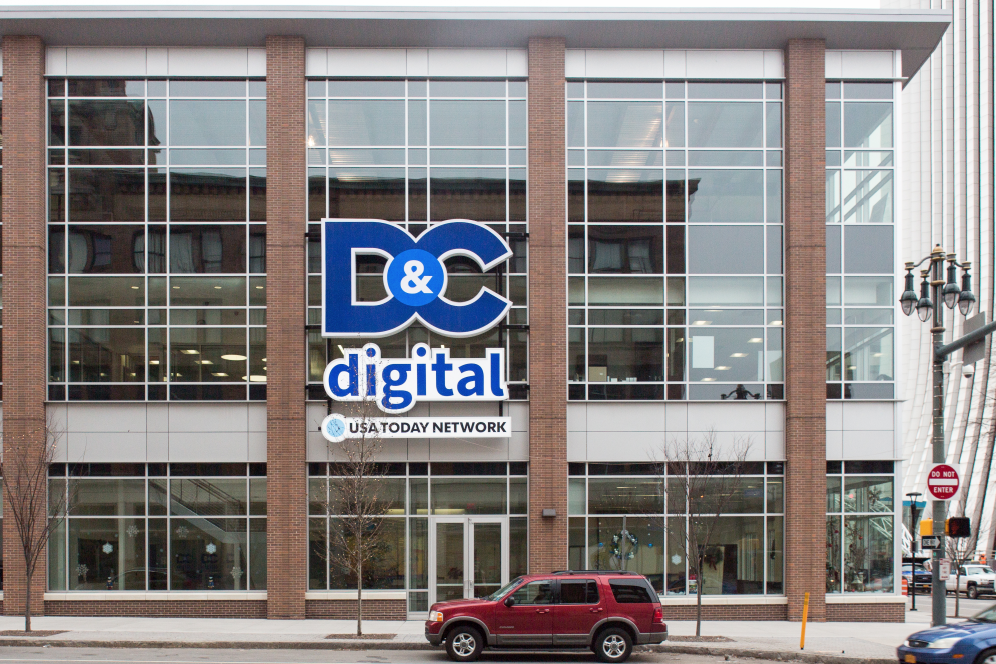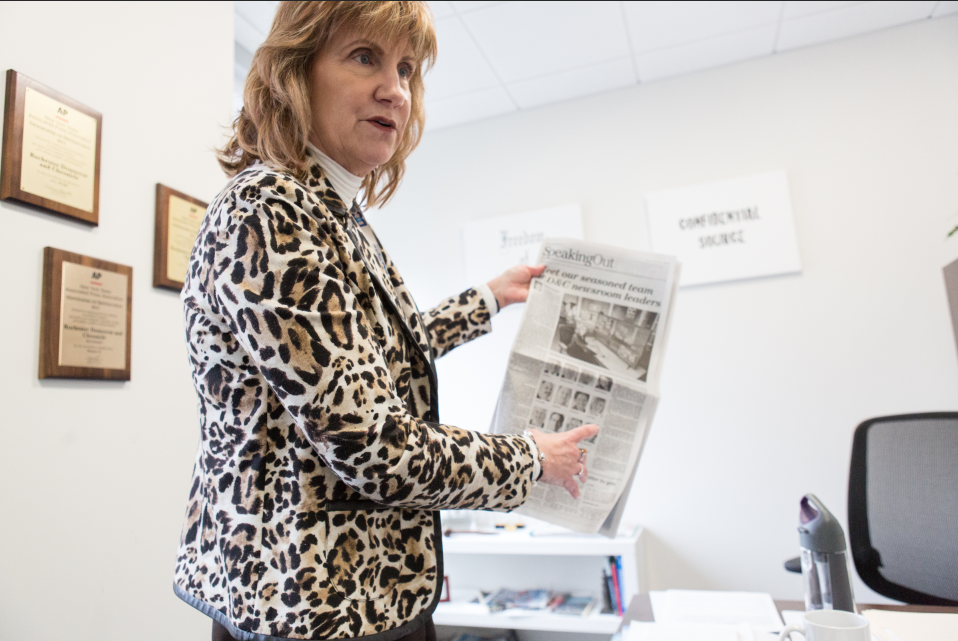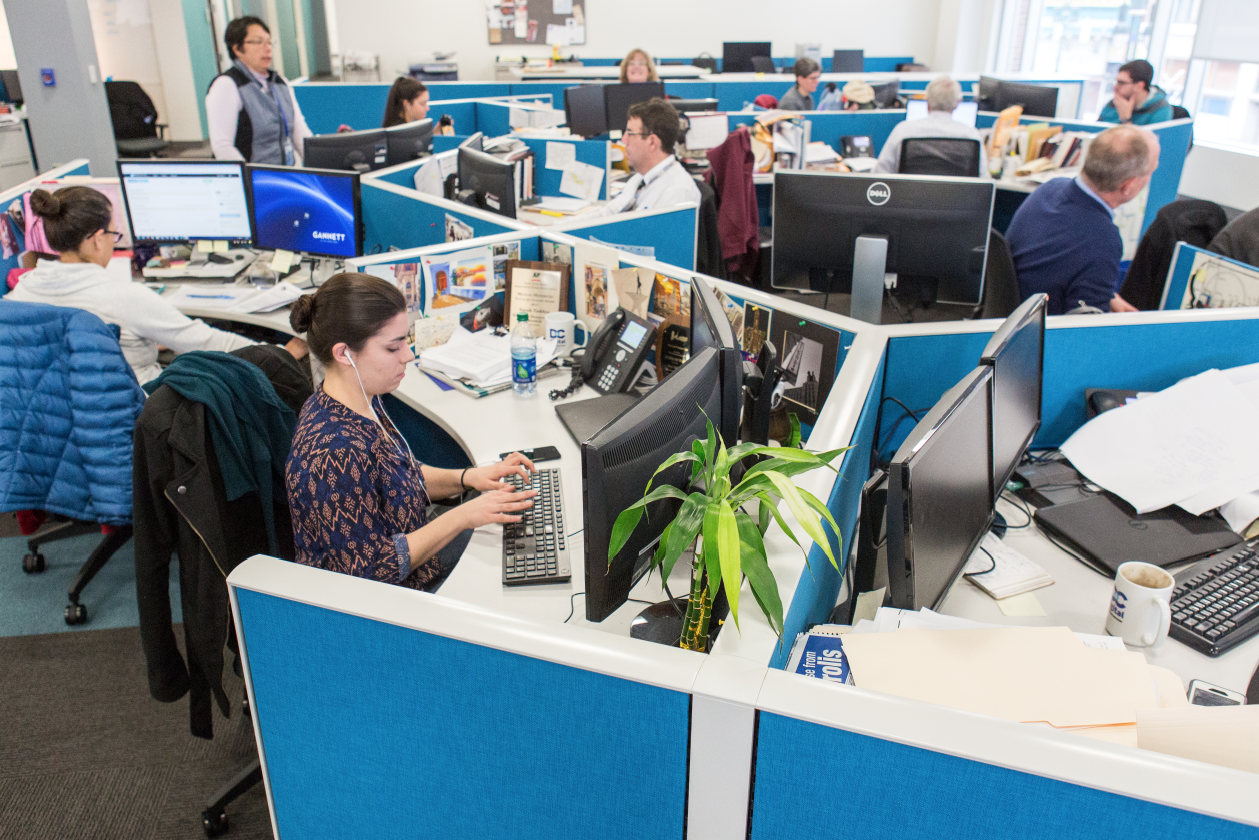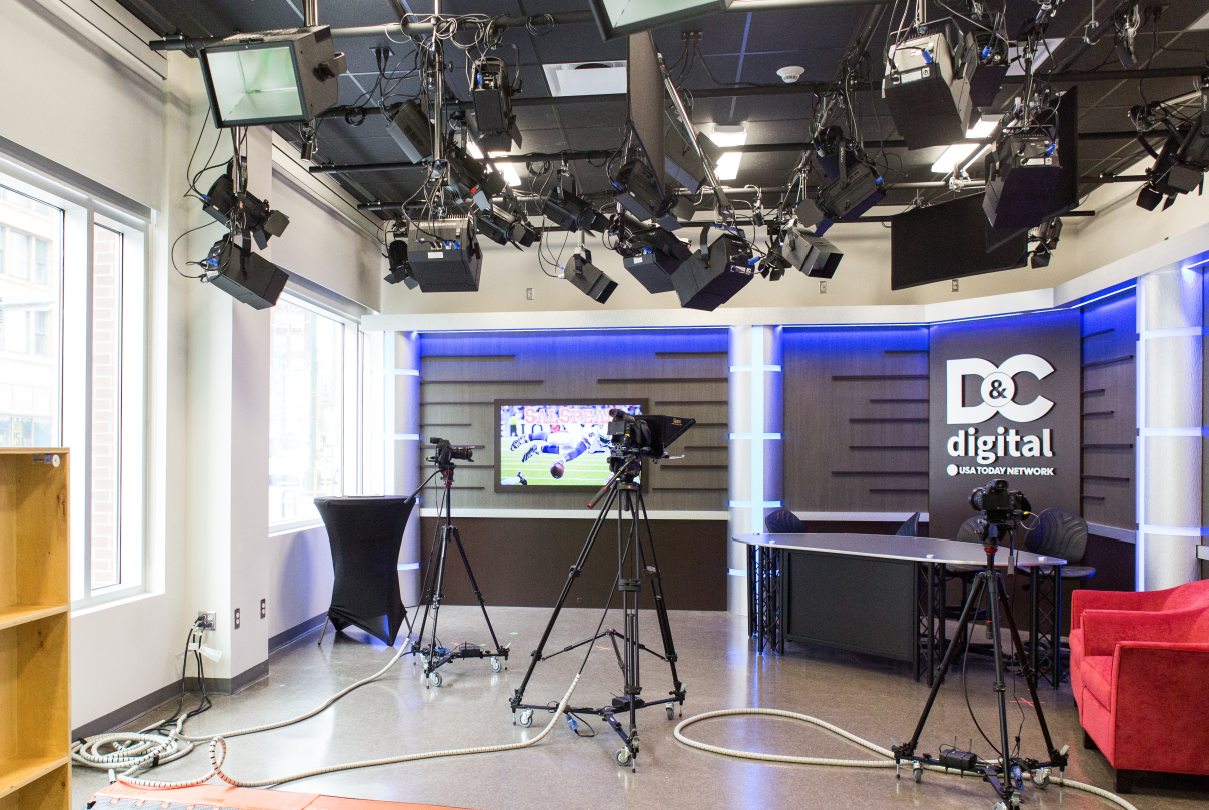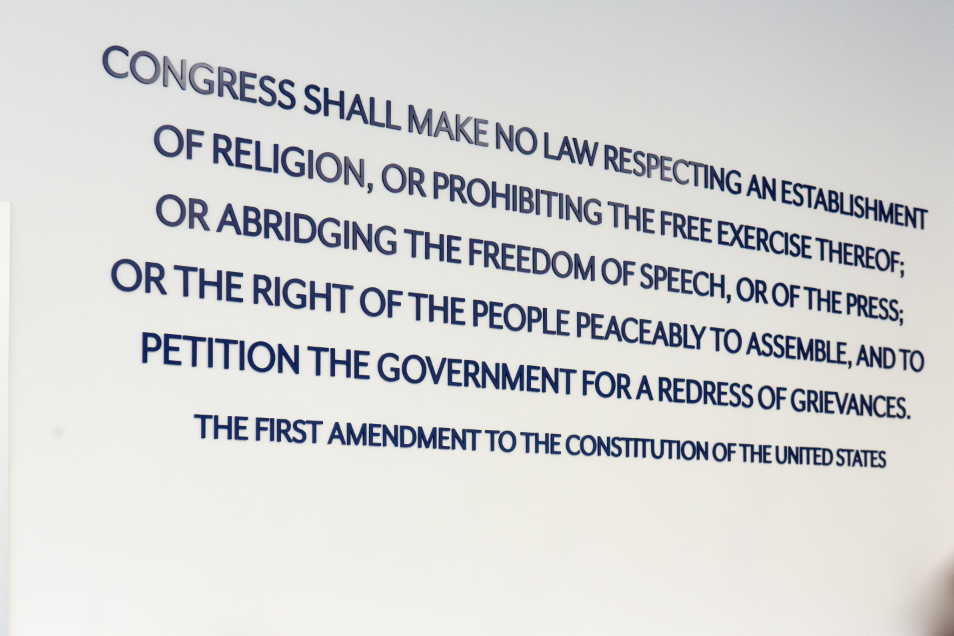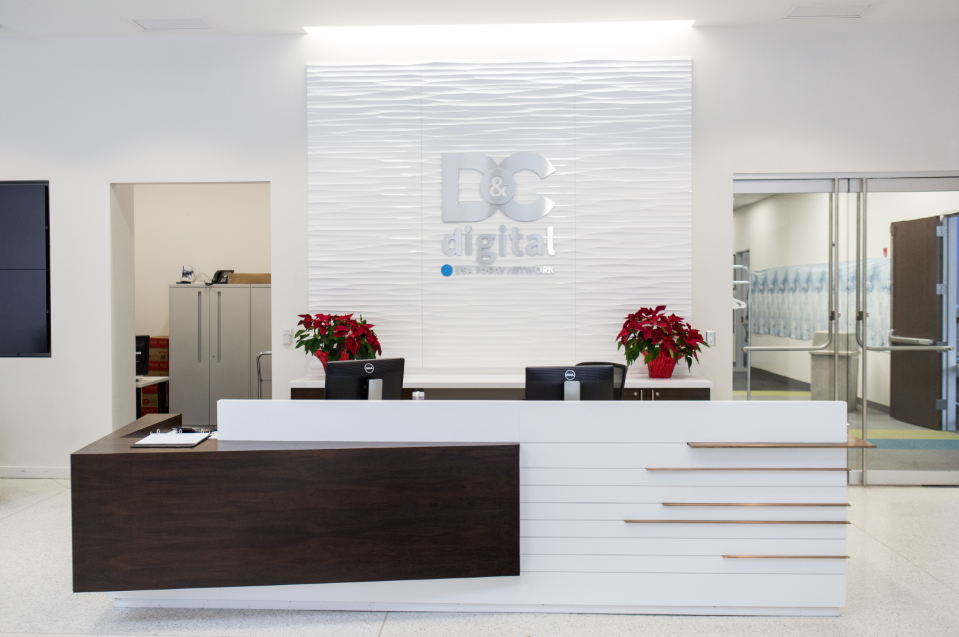A large, naturally-lit entryway welcomes the visitors of D&C Digital, a beautiful new building which houses the Democrat and Chronicle. What is not immediately apparent are the pods of hard-working journalists on the second floor, the sales and marketing teams, photographers and videographers, all working together to produce high-quality news.
The newsroom at D&C Digital is a sight to behold. Five televisions line "Mission Control," monitoring the news and following traffic trends on their website. The open workspace environment facilitates the communication necessary to produce excellent journalism. Journalism is about more than just releasing stories; it is about investigating corruption, keeping the government accountable and educating the community. As the world becomes more digital, journalists must adapt to the changing landscape, and the Democrat and Chronicle (D&C) is doing just that.
How the News Gets Reported
Sarah Taddeo, suburban trends reporter, joined D&C in April 2014 and excels at her job, having won the prestigious Michael Hendricks Young Journalist Award. She sat down to talk with Reporter about journalism.
Her day starts with the "A-team," a group of reporters who tackle breaking news in the early morning.
“We’ll come in, have a meeting, talk about what we’ve seen on social media the day before or overnight and see how we … could get them out on our site," she said. "We try to get them up as quickly as we can.”
She then typically tries to start on a story pitched at that meeting or an idea that has been on her mind. Story ideas can come from social media, press releases or an editor. Taddeo said that while there are many ways a story can come to her, ideas most often come from residents through email or social media.
Investigative pieces tend to take longer, as many sources must be gathered and the piece is longer, so she will dedicate some time in her day to tackling those. She does interviews throughout the day as sources get back to her. Taddeo will record the interviews and then spend time pulling quotes from them to use in her articles. Between 12 and 3 p.m., Taddeo will submit completed stories and then she will go back and forth with an editor to improve them.
Taddeo will sometimes shoot photographs and videos for her own stories. “A typical shoot day could be: shoot some video, talk to a source at 10 in the morning, come back, put together the video and write the story after the video," Taddeo said. "A video can be a short snippet of the story, so it's actually better, sometimes, for me to do that before I write the story so I can get a really encapsulated view.”
During the editorial and writing process, the writers will also be thinking about art. Taddeo will take photos and video herself or reach out to staff photographers and videographers. Then, if the article is for print, it will go off to the designers in the afternoon. In the case of time-sensitive coverage, like sports and breaking news, the piece will go to design later in the day.
The designers are located in New Jersey and work for multiple papers that are owned by D&C Digital's parent company, Gannet Company, Inc. Editors talk to the designers about their expectations for longer stories and decide where the story will appear in the paper. At midnight, the design is sent to the presses, located in Canal Ponds Business Park in nearby Greece, NY.
The newsroom itself contains 55 people, in addition to many freelance contributors.
Karen Magnuson, editor and vice president of the news department, leads the busy newsroom from the center. While she has an office off to the side, she prefers to sit at her desk, identical to the others, on the newsroom floor.
"There is no typical day," Magnuson said.
"There is no typical day," Magnuson said about her job. “I try to spend time in three different areas. Number one, working with the leadership team on day-to-day news. Number two, strategic planning for the future. And number three, people development.”
Being an editor is about more than just correcting grammar. In fact, Magnuson only looks at the Sunday packages, highly sensitive articles and special reports, letting her team of editors do the rest. Part of her job includes meeting with the executive committee, which involves all the of the major parts of producing a paper and website. Sales, marketing and production team leaders all sit at that table.
“We all have a weekly meeting to talk about what we’re working on," Magnuson said. "We figure out how we can align ourselves to make sure that we’re doing the best we can to serve our customers and grow our business.”
The Why of Journalism
"Congress shall make no law respecting an establishment of religion, or prohibiting the free exercise thereof; or abridging the freedom of speech, or of the press; or the right of the people peaceably to assemble, and to petition the Government for a redress of grievances," states the First Amendment of the U.S. Constitution.
"Congress shall make no law respecting an establishment of religion, or prohibiting the free exercise thereof; or abridging the freedom of speech, or of the press; or the right of the people peaceably to assemble, and to petition the Government for a redress of grievances," states the First Amendment of the United States Constitution.
At D&C Digital, there is a large room for holding meetings, often with the public, called the First Amendment room. The words of the First Amendment, the amendment that establishes the rights of the press, adorn one of the walls. For Magnuson, freedom of the press isn't just a right; it's a responsibility.
“I call that our First Amendment responsibilities," she explained. "Being a watchdog for the community, that’s our highest priority.”
While Magnuson considers holding the government accountable to be the highest priority, journalism serves many other positions in society. Journalism can bring communities together by spreading information and inciting discussion. In a special edition of the paper, announcing its move to the D&C Digital building, Erica Bryant, a columnist, laid out the mission of D&C: "Find the truth. Tell good stories. Give people information they will value."
"Find the truth. Tell good stories. Give people information they will value."
“We try to help readers understand what’s going on in their communities and collect various viewpoints for them to read about," Taddeo said.
Larger news organizations are sometimes unable to keep in touch with large reader bases, and therefore can seem out of touch. Local news organizations like the D&C are able to focus on the community and write stories that readers can connect with on a personal level. Magnuson explained that local media organizations allow readers to have a voice by sharing their opinions through their website, social platforms and letters to the editor.
“I can’t imagine a job that would be any more fulfilling, or more rewarding for me … You’re really serving the community,” Magnuson explained.
When talking to them, it is clear that both Taddeo and Magnuson love what they do and take their jobs very seriously.
“I’m like a platform and a conduit for people to be able to share what they’re thinking about our community,” Taddeo said.
Fake News
In recent months, the prevalence of fake news on websites such as Facebook has become obvious. The sharing nature of social media makes it easy to spread false stories, especially when people share without first fact-checking the article.
“[Be] engaged with your journalist … rather than relying on your Facebook news feeds to tell you the truth about things," Taddeo said, although she encourages readers to check their reputable organizations for bias. “We take [feedback] to heart, so if you notice that we have a bias, or that we’re not covering something, tell us.”
Instead of trusting a single article, Taddeo suggests looking into other sources and trying to read different viewpoints. Pay attention to the website hosting the article in question and determine if it is a reliable source of information.
Magnuson explained that the D&C is very concerned about fake news and is trying to become more open about their process to combat it.
"Every year the Democrat and Chronicle's Editorial Board sets an agenda outlining the issues that we will prioritize over the next 12 months … In 2017, we are including an overarching ideal. Transparency," explained the D&C's Jan. 1 editorial. "A healthy democracy requires honest and complete information on which to base critical decisions, recognize wrongdoing and emulate successes," the editorial explained.
"A healthy democracy requires honest and complete information on which to base critical decisions, recognize wrongdoing and emulate successes," explained the D&C's Jan. 1 editorial.
The landscape of media is changing, however, and journalists must adapt to continue providing their service.
The Digital Age
The D&C has always prided itself on being at the forefront of new technology.
"In 1997, in partnership with Kodak and Rochester Institute of Technology, we became the first metro newspaper in the United States to move from film to 100 percent digital photography," wrote Dennis Floss, director of client strategy, in an article for D&C.
This ideal hasn't changed as media becomes more digital, but that doesn't mean D&C will abandon the print edition anytime soon.
"[D&C has] one of the highest reaches of audience in the country, for the size of our market," Magnuson said.
"We reach more than 50 percent of the adults in this market," Magnuson said. “We have one of the highest reaches of audience in the country, for the size of our market.”
While the print edition still has life, D&C Digital understands that digital is the future. The rebranding and new building are a testament to that. The large windows on the outside of the building reveal a large multipurpose studio equipped with television cameras, a news-anchor desk and a green screen.
"It's a brave new world in newspapers, and video production has become integral to their storytelling," said David Andreatta in an article about the studio.
In a quote for Magnuson's editorial, News Director Dick Moss said that "Good information will always be valuable. That doesn't change no matter what medium it is conveyed through."
"Good information will always be valuable," News Director Dick Moss said in a quote for Magnuson's editorial.
It is no secret that younger generations prefer to consume their news digitally. However, a fully digital D&C won't be seen in the near future, as there is still a strong print market in Rochester, especially among older generations.
“A lot of people still want to see a really well-designed, well-executed paper on their doorstep every day,” Taddeo said.
Democrat and Chronicle is truly that, a well designed, well executed paper. And it is more than that. D&C Digital is a website, a collection of passionate staff, a standard of journalistic integrity, an innovator of digital media, a government watchdog. It is Rochester's largest news organization. It is Rochester's voice.




